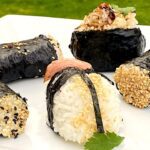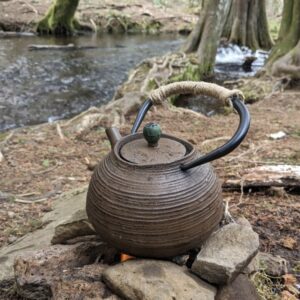ONIGIRI with DARJEELING INFUSED RICE
ONIGIRI with DARJEELING INFUSED RICE
 Onigiri is considered Japanese soul food and compared to easy grab ‘n go foods like burritos and hotdogs because they share the same definition for perfect hand-held, walk-about snacks. Onigiri is a rice ball, typically wrapped in seaweed. It was invented before the existence of refrigeration as a way of preserving fresh rice with pickled fillings so it could carry along with people traveling, for soldiers on foot, and farmers working in the fields. Onigiri is still one of the most popular snacks in Japan and is enjoyed by people of all ages. In some regions of Japan, onigiri is also called omusubi, which is associated with Japanese folklore and specifically refers to the triangle formed onigiri. The rice is squeezed into a “mountain shape” as a symbol and hope to receive the power of God. History shows that travelers carried these triangle-shaped snacks with them as a way of requesting safe travels from the spirits who inhabited nature. From what I understand, only
Onigiri is considered Japanese soul food and compared to easy grab ‘n go foods like burritos and hotdogs because they share the same definition for perfect hand-held, walk-about snacks. Onigiri is a rice ball, typically wrapped in seaweed. It was invented before the existence of refrigeration as a way of preserving fresh rice with pickled fillings so it could carry along with people traveling, for soldiers on foot, and farmers working in the fields. Onigiri is still one of the most popular snacks in Japan and is enjoyed by people of all ages. In some regions of Japan, onigiri is also called omusubi, which is associated with Japanese folklore and specifically refers to the triangle formed onigiri. The rice is squeezed into a “mountain shape” as a symbol and hope to receive the power of God. History shows that travelers carried these triangle-shaped snacks with them as a way of requesting safe travels from the spirits who inhabited nature. From what I understand, only this shape is called omusubi. The word onigiri comes from nigirimeshi which translates “to squeeze.” Squeezing is the technique used to form the rice into a shape that binds it together. I was thankful to learn about this because some of the onigiri I made, were definitely NOT triangles.
this shape is called omusubi. The word onigiri comes from nigirimeshi which translates “to squeeze.” Squeezing is the technique used to form the rice into a shape that binds it together. I was thankful to learn about this because some of the onigiri I made, were definitely NOT triangles.
Onigiri is most often eaten cold or at room temperature, however, you can serve them warm by simply toasting your shapes in a pan with sesame oil on medium heat for 5-6 minutes per side. This preparation is called yaki onigiri (the recipe can be found at this link ; https://pepperandsaltkitchen.com/2023/02/25/onigiri-japanese-rice-balls/
It takes some practice to get the same perfect little parcels a seasoned onigiri chef creates. As you can see, mine are not perfect, so I’m practicing! With so many shapes to choose from and so many fillings to consider, it’s a fun family activity or one you might consider for a party. There are also onigiri molds you can buy to make the crafting a little easier. I’ve listed one below. You can find more on Amazon and in Asian markets.
Makes 8 -10 pieces
INGREDIENTS FOR ONIGIRI
- 2 C sushi rice (Japanese short grain)
- 2-1/2 C water
- Nori sheets, unseasoned
- Kosher salt
- 1 C toasted sesame seeds (black or white or both)
- Fillings such as salmon, sesame spinach, bean paste, teriyaki chicken or pork, tofu & green onion
- Garnishes such as mint, cilantro, chopped chives, chopped scallions,
- chili flakes
Dipping sauce: Place rice into a medium-sized sieve and run cold water over it, rubbing the rice between your fingers. Continue to do this until the water runs clear out of the sieve. In a medium size saucepan, add rice and cover with 2-1/2 cups of steeped Darjeeling tea. Bring to a boil, cover with lid, reduce heat to low, and simmer for approximately 10 minutes or until the tea has been completely absorbed. Cut nori sheets into one-inch or two-inch wide strips and set aside. Prepare your fillings and garnishes while the rice is cooking.
- Smoked salmon, green onion & tamari
- Sesame tamari ginger marinated tofu & chives (vegan)
- Umeboshi (recipe link below) (vegan)
- Avocado & blister peanut (vegan)
- Teriyaki chicken (chopped) & shichimi togarashi (Japanese 7-spice)
- Sesame sautéed spinach, edamame & hoison (vegan)
- Sweet potato & shallot (vegan)
- Japanese red bean paste (Organic Anko Japanese Red Bean Paste is found in Asian stores and Amazon)
An approximate teaspoon of any filling goes in the center of each form, so you only need very small amounts of each.
When the rice is cool enough to handle and you have your assembly board set up with fillings, garnishes, and cut nori sheets, you can begin. Wet your hands with cold water and a tiny pinch of salt and with 1/3 cup (or more) of rice begin molding your shape in the palm of your hand. Squeezing the rice until it’s in a tight form. This can be a ball, cone, triangle, square, or oval. Once you have a shape, make a dip in the middle of the shape and spoon in 1/2 to 1 whole teaspoon of filling. How much filling you put in will depend on how big your shape is. Because of my skill level at this point, I found that adding just a little more rice to cover the filling was required. If you do this, squeeze your shape again to tighten the additional rice. Add nori to the shape, leaving a bit of the rice showing. You can use a tiny bit of water on the end of the nori to get the nori to “glue” together, if necessary. Sprinkle with sesame seeds. Garnish. Continue with the next shape.
FOR THE DIPPING SAUCE
- 1/4 C tamari or shoyu
- 2 T rice vinegar
- 1 T white sugar or agave
- 1 tsp dark sesame oil
- 1 tsp fresh grated ginger
- 1 T finely chopped scallion
- 1/2 tsp red chili flakes
Stir all ingredients in medium size bowl until well incorporated.
COOK’S NOTES:
- To keep onigiri fresh until serving, cover with plastic wrap.
- For refrigeration: you can individually wrap onigiri in plastic wrap and then cover it with a kitchen towel. You can store up to two days in the refrigerator. Pull out of the refrigerator at least 30 minutes before eating to bring onigiri back up to room temp. For yaki onigiri, you can gently warm it up in a cast iron pan.
- A good way to identify different rice ball offerings is to garnish each one with a bit of the filling
- If you want to take a peek at the how-to’s of making onigiri, there are many videos online that show the technique OR you can get molds (see below) to help shape things a little easier
- Onigiri Triangle Mold – You can find an onigiri rice mold on many sites. Amazon has several. One that I may be getting is Choxila Onigiri Stainless Steel Rice Ball Mold
• Umeboshi Recipe: https://pepperandsaltkitchen.com/2020/09/14/umeboshi-pickled-salted-plums/



 Darjeeling tea inspired this noodle soup. Recipe testing this broth with an infusion of tea took several tries, but we finally landed on one that we really enjoyed. It isn’t overwhelmingly tea forward but just enough so the essence of Darjeeling snuggles in nicely with the chicken broth and spices. This is a warming, comforting soup. The combination of noodles and meatballs swimming in a broth of sunshine is perfect on a cloudy day. Serve with a simple green salad or green onion pancakes and your favorite beverage.
Darjeeling tea inspired this noodle soup. Recipe testing this broth with an infusion of tea took several tries, but we finally landed on one that we really enjoyed. It isn’t overwhelmingly tea forward but just enough so the essence of Darjeeling snuggles in nicely with the chicken broth and spices. This is a warming, comforting soup. The combination of noodles and meatballs swimming in a broth of sunshine is perfect on a cloudy day. Serve with a simple green salad or green onion pancakes and your favorite beverage.
 First, the water must steam. Next, the leaves must steep. Then, the tea must cool. Finally, you may enjoy. The act of making tea is a process that asks you to slow down for a moment and create something for yourself with intention. The warm cup in your hands, the hot tea flowing past your lips, the feeling in your heart as you swallow it. Tea is sensational, it gets you in touch with your body as well as your mind. It’s also a process to hone; you learn how to work with your equipment and in that way you develop a relationship with your kettle, teacup and steeper. You learn the small adjustments that you like to make the tea to your liking. Tea slows you down and gets you in touch with yourself.
First, the water must steam. Next, the leaves must steep. Then, the tea must cool. Finally, you may enjoy. The act of making tea is a process that asks you to slow down for a moment and create something for yourself with intention. The warm cup in your hands, the hot tea flowing past your lips, the feeling in your heart as you swallow it. Tea is sensational, it gets you in touch with your body as well as your mind. It’s also a process to hone; you learn how to work with your equipment and in that way you develop a relationship with your kettle, teacup and steeper. You learn the small adjustments that you like to make the tea to your liking. Tea slows you down and gets you in touch with yourself. a mushroom medley, or absorb the high caffeine content of a matcha latte. To drink a cup of tea is to build a connection between you and another organism, to receive support from plants that humans have been cultivating and nourishing for centuries to receive their gifts of healing and joy. You’re granted the privilege of strengthening and elevating yourself with support from another.
a mushroom medley, or absorb the high caffeine content of a matcha latte. To drink a cup of tea is to build a connection between you and another organism, to receive support from plants that humans have been cultivating and nourishing for centuries to receive their gifts of healing and joy. You’re granted the privilege of strengthening and elevating yourself with support from another. When you make yourself a cup of tea you’re doing something nice for yourself. You don’t need tea to survive, even though it may feel like it sometimes. Tea is a treat, and the drinking and preparation of tea is taking time out of your busy life to make yourself a treat. Not only is the tea itself tasty and beneficial, but also the manner in which you prepare it. In Iran, for example, it’s traditional to hold a sugar cube between your teeth while you drink strong tea, and in India you’ll experience the more spiced blends that we call chai here in the West. In my house I have a special teapot just for my favorite tea, my friend has an iced tea jug that they cold steep their tea in to keep in the fridge. I’ve even had tea served to me by boiling water in a pot on the stove, and having it poured over a tea bag. I have, however, gifted them a steeper and some loose-leaf tea since then. There’s no wrong way to enjoy tea, and it’s an opportunity for self expression and personalizing your experience to suit your tastes. Whether you’re using an electric kettle with temperature control or eyeballing the steam level on your gaiwan, it’s your experience and it’s unique.
When you make yourself a cup of tea you’re doing something nice for yourself. You don’t need tea to survive, even though it may feel like it sometimes. Tea is a treat, and the drinking and preparation of tea is taking time out of your busy life to make yourself a treat. Not only is the tea itself tasty and beneficial, but also the manner in which you prepare it. In Iran, for example, it’s traditional to hold a sugar cube between your teeth while you drink strong tea, and in India you’ll experience the more spiced blends that we call chai here in the West. In my house I have a special teapot just for my favorite tea, my friend has an iced tea jug that they cold steep their tea in to keep in the fridge. I’ve even had tea served to me by boiling water in a pot on the stove, and having it poured over a tea bag. I have, however, gifted them a steeper and some loose-leaf tea since then. There’s no wrong way to enjoy tea, and it’s an opportunity for self expression and personalizing your experience to suit your tastes. Whether you’re using an electric kettle with temperature control or eyeballing the steam level on your gaiwan, it’s your experience and it’s unique.